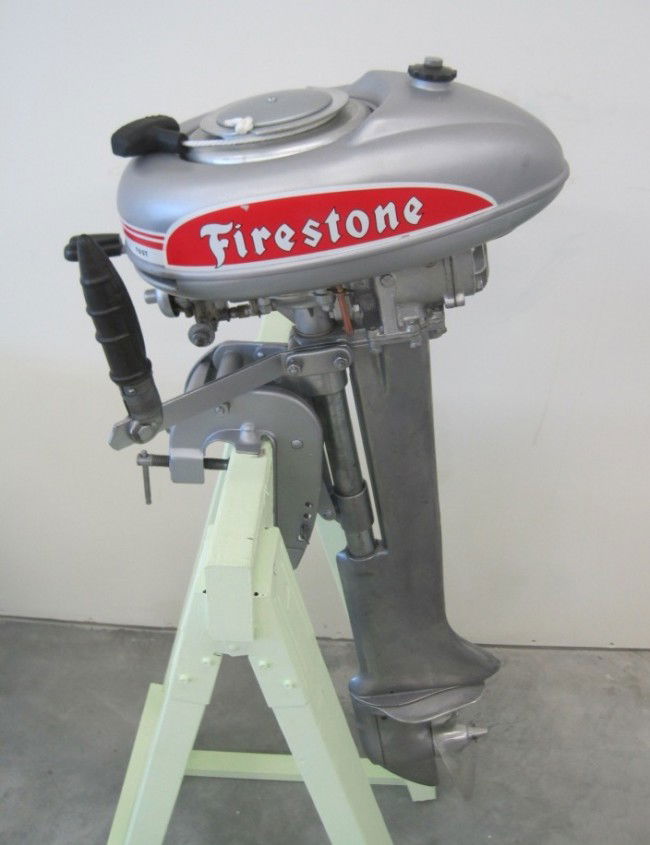Firestone Outboard Motor Service Manual
A History Of The Scott-Atwater Outboard Motor Company In 1932, Cliff Scott and H. Bruce Atwater started a small tool making and punch press operation.
They quickly established a reputation for quality, and in 1935 Earl DuMonte approached them to build a small outboard for him to sell. DuMonte displayed the motors at a New York exhibit.
Several hundred outboards were ordered. As DuMonte had purchased the name and rights to the Champion outboard motor from Sig Konrad, they shipped with the brand name CHAMPION. From 1935 to 1939, Scott and Atwater still operated their tool and punch press business as well as building outboards. In 1939 DuMonte landed a contract with Firestone to sell the CHAMPION in their tire stores. Scott and Atwater turned to building outboards full time. In 1941 Scott and Atwater with their CHAMPION outboards were the second largest outboard manufacturer in America.
Only Evinrude was larger. This relationship with DuMonte and the CHAMPION outboards lasted until 1942. World War II forced most machine shops to shift to doing military work. Scott and Atwater were no exception. After the war, Earl DuMonte and Scott/Atwater parted ways, although they would remain on friendly terms.
Firestone, sensing a pent up demand after the war, stayed with Scott and Atwater to supply their motors. In 1946 FIRESTONE outboards reentered the market. Scott and Atwater would also offer motors through the more traditional boat stores under the SCOTT-ATWATER brand. The only size available in 1946 was a 3.6 Hp.
Firestone Outboard Boat Motor
They added a 7.5 in 1947. By 1949 the line had grown to a 3.6, 4, 5, and 7.5 Hp. The 4 to 7.5 Hp outboards were available with 'Full Shift' F-N-R (forward-neutral-reverse). Scott-Atwater and Firestone were the first outboards with a line of shiftable motors.
In 1950 they added a 16 Hp shift motor, and in 1951 10 hp. In 1951, Scott Atwater experimented with speed designations on their line of outboards. Numbers on the cowlings were for a speed rating. For example, the 3.6 Hp was designated 1-12. Under ideal conditions, the motor would troll under 1 mph and could achieve a top speed of 12 mph.
This speed designation was only used in 1951 and 1952. The experiment proved too confusing and set unrealistic expectations (ala mpg ratings on new care stickers) and was dropped In 1952 the 4 hp was dropped from the line. 1953 brought about the Golden Pennant 7.5 and 10 Hp. A new dark green bottom and a gold split cowl. The outboards were a new slimmer design and didn't sell as well as expected.
The Golden Pennant lasted only that one year. In 1954, the new color scheme was extended to all the models of the line.
The split cowl was abandoned in favor of a one piece, lift off design. From 1954 to 1956 Scott Atwater's were the prettiest motors available, with their art deco coloring and sleek design (author's opinion). 1954 also saw the introduction of the the Bail-A-Matic on the 5, 7.5, 10 and 16 Hp motors.

This feature would allow you to drop a small immersion unit in the bottom of a boat and a neoprene hose connected a pump in the outboard would bail the boat. Most boats of the day were wood and had the tendency to leak a little water. At the same time, fiberglass and aluminum boats were becoming popular, and the Bail-A-Matic would fail as a popular feature.
In 1955 Scott Atwater introduced their 30 hp outboard. In 1956 it was changed to a 33 hp. Their line for 1956 was a 3.6, 5, 7 1/2, 10, 16 manual start, 16 electric start and a 33 hp. In 1956, Scott-Atwater was approached by McCulloch to buy their outboard operation. Scott-Atwater did sell out this same year. In 1956, Scott-Atwater ended production Corsair outboard, an outboard that Scott-Atwater had produced since 1946. In 1957 the 33 hp became a 40 hp.
Although the name Scott-Atwater was still on the cowling, the company, now owned by McColloch, called themselves Scott. Fiberglass cowlings appeared on some of the outboards. In 1958 the new 3 cylinder 60 hp was introduced.
The name brand name on the outboards eventually became Scott and Scott-McCulloch. By 1964 all of the motors were McCulloch only. By 1966, McCulloch was looking for a buyer for the outboard motor business. Management had decided to concentrate on their core landscape equipment business.
Lacking a buyer, they folded the outboard division in late 1967. The following brands were produced by Scott-Atwater.
Some brands (Firestone) would be licensed to other manufacturers after being discontinued by Scott-Atwater. Champion outboards 1935-1942 Scott-Atwater 1946-1959 Firestone Outboards 1946-57 Corsair Outboards 1948-1957 Hiawatha 1956-1959 Wizard 1959-? This was only added because in 1959 and or 1960 the Bail-A-Matic feature was on some of these outboards that McCulloch produced for Western Auto. Credits: Much of the above information was supplied by Wes Bailey. Other sources quoted are the Scott-Atwater Service Manuals, as well as Scott-Atwater sales literature of the era. It never fails to surprise me just how much literature of the time has survived, and how much is available on ebay.